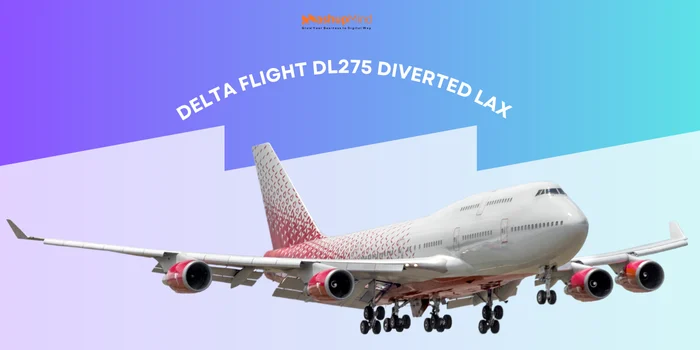On May 28, 2025, Delta Flight DL275 diverted to LAX after a serious technical issue forced pilots to change course. The flight, operated on an Airbus A350-900 from Detroit Metropolitan Airport to Tokyo Haneda, developed a fault in its Rolls-Royce Trent XWB engine anti-ice system mid-flight.
The Delta Flight DL275 Japan diversion LAX incident made global headlines as more than 300 passengers were delayed and rebooked. Thankfully, no injuries were reported. The event highlighted the importance of airline safety decisions, the financial impact of diversions, and how predictive technology could prevent similar situations in the future.
The Delta Flight DL275 diverted LAX today story is not just another emergency—it stands as a case study in modern aviation safety, airline operations, and the role of advanced maintenance systems.
What Happened on Delta Flight DL275?
Delta Flight DL275 departed Detroit on the morning of May 28, 2025, scheduled for Tokyo Haneda. Roughly five hours into the journey, cockpit warnings indicated a malfunction in the aircraft’s engine anti-ice system. This system prevents ice buildup inside the engines, which, if unchecked, can reduce airflow, power, or even cause engine failure.
Continuing across the Pacific was deemed unsafe. The crew diverted to Los Angeles International Airport (LAX), a major Delta hub with the facilities and technical expertise needed to handle the Airbus A350.
At 1:08 AM local time, Delta Flight DL275 landed safely at LAX after more than 12 hours of flying. All passengers and crew were unharmed.
Why Was LAX the Best Diversion Option?
The Delta Flight DL275 diversion to LAX was chosen for multiple reasons:
- Delta Hub Advantage – LAX has Airbus A350 maintenance facilities, parts, and certified Rolls-Royce staff.
- Runway Length – The A350 required long runways for a safe landing with extra fuel on board.
- Passenger Services – Los Angeles offered better hotel, rebooking, and support options for over 300 travelers.
Thus, the Delta Flight DL275 Japan diversion LAX was the safest and most practical choice.
Timeline of the Delta Flight DL275 Diverted LAX Today
- Departure: Morning of May 28, 2025, from Detroit Metropolitan Airport.
- Midway over the Pacific: Anti-ice system fault detected.
- Course Change: Crew diverted westward toward California.
- Arrival: Delta Flight DL275 diverted LAX today at 1:08 AM local time.
For passengers, the unplanned stop caused delays, but safety came first.
Technical Details of the Engine Fault
The Rolls-Royce Trent XWB engines rely on hot bleed air to prevent ice. On DL275, system readings showed:
- Airflow dropped by 50%
- Bleed air pressure reduced by 25%
- Valve response slowed by 300%
- The temperature fell 30% below standard
While not an immediate fire risk, this issue was critical for a long trans-Pacific flight, making diversion unavoidable.
Passenger Experience on Delta Flight DL275
Passengers reported the Delta Flight DL275 diverted LAX situation as tense but calm.
- The captain communicated clearly about the issue.
- Flight attendants reassured travelers.
- Relief came when the Airbus A350 touched down safely.
Despite missed connections and delays, most agreed that safety was the top priority.
Financial Impact of the Delta Flight DL275 Japan Diversion LAX
Flight diversions are costly. Estimated breakdown:
- Direct Costs: $332,000 (fuel, emergency landing, repairs, crew hotels)
- Passenger Costs: $176,000 (rebooking, meals, hotels, compensation)
- Lost Revenue: $2.3 million (cancelled Tokyo leg, cargo losses, ripple effects)
The Delta Flight DL275 diverted LAX today incident cost the airline nearly $2.8 million.
How Delta Handles Diversions
Delta has strict diversion procedures:
- Pilots follow safety-first protocols.
- Dispatch teams coordinate with air traffic control.
- Ground crews handle rebooking, hotels, and meals.
- Maintenance begins immediately.
The Delta Flight DL275 diversion to LAX demonstrated these systems in action.
Could Predictive Technology Have Prevented This?
Airlines are investing in AI-driven predictive maintenance. These systems analyze sensor data to detect faults before they occur.
In the case of Delta Flight DL275 diverted LAX, stronger predictive tools might have flagged the anti-ice fault before departure, preventing the disruption.
The Delta Flight DL275 Japan diversion LAX proves why predictive technology is vital for the future of aviation.
Final Thoughts
The Delta Flight DL275 diverted LAX today incident highlighted airline safety, technical challenges, and the role of predictive maintenance. The Delta Flight DL275 Japan diversion LAX proved that quick, professional decisions by pilots and crews protect lives—even when costly disruptions occur.
For passengers, the experience was stressful but safe. For aviation, it was a reminder that technology, training, and planning make every diversion a lesson in safety first.
FAQs About Delta Flight DL275 Diverted LAX
Why was Delta Flight DL275 diverted to LAX?
The Airbus A350 developed a fault in its Rolls-Royce Trent XWB engine anti-ice system.
When did Delta Flight DL275 land at LAX?
It landed at 1:08 AM on May 28, 2025 after about 12 hours in the air.
How much did the diversion cost?
The financial impact was about $2.8 million in direct, passenger, and lost revenue costs.
How many passengers were affected?
Over 300 passengers were delayed and rebooked, many receiving hotels and compensation.
Are diversions dangerous?
Not usually. They are precautionary, and crews are trained extensively for such scenarios.
How often do diversions happen?
They are rare compared to daily flights worldwide but occur due to weather, medical emergencies, or technical issues.







